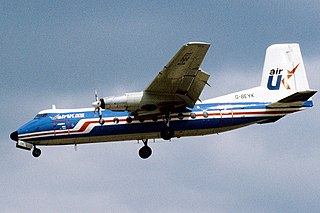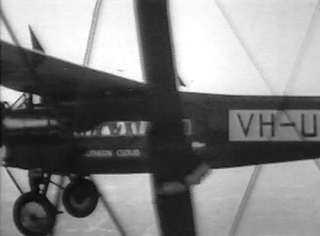
The HS 748 is a medium-sized turboprop airliner originally designed and initially produced by the British aircraft manufacturer Avro. It was the last aircraft to be developed by Avro prior to its absorption into Hawker Siddeley.

The British Aerospace 146 is a short-haul and regional airliner that was manufactured in the United Kingdom by British Aerospace, later part of BAE Systems. Production ran from 1983 until 2001. Avro International Aerospace manufactured an improved version known as the Avro RJ. Production for the Avro RJ version began in 1992. Later on, a further-improved version with new engines, the Avro RJX, was announced in 1997, but only two prototypes and one production aircraft were built before production ceased in 2001. With 387 aircraft produced, the Avro RJ/BAe 146 is the most successful British civil jet airliner program.

The Fokker F27 Friendship is a turboprop airliner developed and manufactured by the Dutch aircraft manufacturer Fokker. It is the most numerous post-war aircraft manufactured in the Netherlands; the F27 was also one of the most successful European airliners of its era.

The Avro York was a British transport aircraft developed by Avro during the Second World War. The design was derived from the Avro Lancaster heavy bomber, several sections of the York and Lancaster being identical. Due to the importance of Lancaster production, York output proceeded slowly until 1944, after which a higher priority was placed upon transport aircraft.

The Avro 691 Lancastrian was a British and Canadian passenger and mail transport aircraft of the 1940s and 1950s developed from the Avro Lancaster heavy bomber. The Lancastrian was basically a modified Lancaster bomber without armour or armament and with the gun turrets replaced by streamlined metal fairings, including a new nose section. The initial batch was converted directly from Lancasters; later batches were new builds.

Koninklijke Nederlandsch-Indische Luchtvaart Maatschappij was the airline of the former Dutch East Indies. Headquartered in Amsterdam, KNILM was not a subsidiary of the better-known KLM, despite the similar name. The airline had its headquarters in Amsterdam and an office in on the grounds of Tjililitan Airfield in Batavia.

MacRobertson Miller Airlines (MMA) was a Western Australian airline that operated between 1927 and 1993. After being purchased by Ansett Transport Industries in 1968, it was eventually rebranded Ansett WA.

The Southern Cross is a Fokker F.VIIb/3m trimotor monoplane that was flown by Australian aviator Charles Kingsford Smith, Charles Ulm, Harry Lyon and James Warner in the first-ever trans-Pacific flight to Australia from the mainland United States, a distance of about 11,670 kilometres (7,250 mi), in 1928.

The Handley Page Dart Herald is a 1950s British turboprop passenger aircraft.

The Fokker F.VII, also known as the Fokker Trimotor, was an airliner produced in the 1920s by the Dutch aircraft manufacturer Fokker, Fokker's American subsidiary Atlantic Aircraft Corporation, and several other companies under license. It was an airliner that could carry 6-12 people, depending on the version, and it used a variety of engines;early versions had one engine but three was more common.

Union Airways of South Africa was the first South African commercial airline. It operated as an independent company for five years, from 1929 to 1934, before being taken over by the government as South African Airways.

The Fokker F-10 was an enlarged development of the Fokker F.VII airliner, built in the late 1920s by the Fokker Aircraft Corporation of America. A trimotor, it carried 12 passengers, four more than the F.VII, and had a larger wing and more powerful engines.

Australian National Airways, Ltd. (ANA) was a short-lived Australian airline, founded on 3 January 1929 by Charles Kingsford Smith and Charles Ulm.

The Short S.16 Scion and Scion II were 1930s British two-engine, cantilever monoplanes built by Short Brothers and by Pobjoy Airmotors and Aircraft Ltd. in Rochester, Kent between 1933 and 1937. Altogether 22 Scion/Scion II aircraft were built and they provided useful service to operators working from small airstrips/water courses in many parts of the globe, including Europe, the Near and Middle East, Sierra Leone, Papua New Guinea and Australia. Many were impressed into the Royal Air Force during the Second World War, providing pilot ferry services, anti-aircraft co-operation and radar calibration duties. Of the civilian Scions, at least two were still operating in Australia in 1966, one having been re-engined with de Havilland Gipsy Minor engines.

The de Havilland DH.61 Giant Moth was a 1920s British large single-engined biplane transport built by de Havilland at Stag Lane Aerodrome, Edgware. Intended primarily for use in Australia, a number were also shipped to Canada.
Keith Allison Virtue MBE was a pioneer Australian aviator. Sir Lawrence Wackett, in the foreword of Keith Virtue's biography, writes that he was an experienced airman himself but he marvelled at the ability and skill of Keith Virtue and counts him as one of the greatest of the Australians who devoted their life's work to the task of pioneering airlines in Australia.

The Southern Cloud, registered VH-UMF, was one of five Avro 618 Ten three-engined aircraft flying daily airline services between Australian cities for Australian National Airways in the early 1930s.

Rottnest Island Airport is a small airport for light aircraft, situated about 800 m (2,600 ft) from the main settlement at Thomson Bay, Rottnest Island and 10 nautical miles northwest of Fremantle. Daily air services operate to the island. In the past these have been from Perth Airport, but in recent years have been mainly from Jandakot.

The Avro 642 Eighteen was a 1930s British monoplane airliner. Only two were built — one twin-engined and the other four-engined. The original had circular partially glazed nose, but this was changed to a more traditional one. It used the wing of the Avro 618 Ten, which was a license produced Fokker V.II.
Hart Aircraft Service Pty. Ltd. was an Australian aviation company registered at Melbourne in mid-1929 with directors James Hart, John Hider and Norman Charles Trescowthick. Director James Hart (c1891-1951) was a former Royal Flying Corp aviator who had flown as gunner for Hereward de Havilland. Norman Trescowthick had served with distinction in the Australian Flying Corps' famous 4th Squadron with Arthur H. Cobby during the First World War.





















